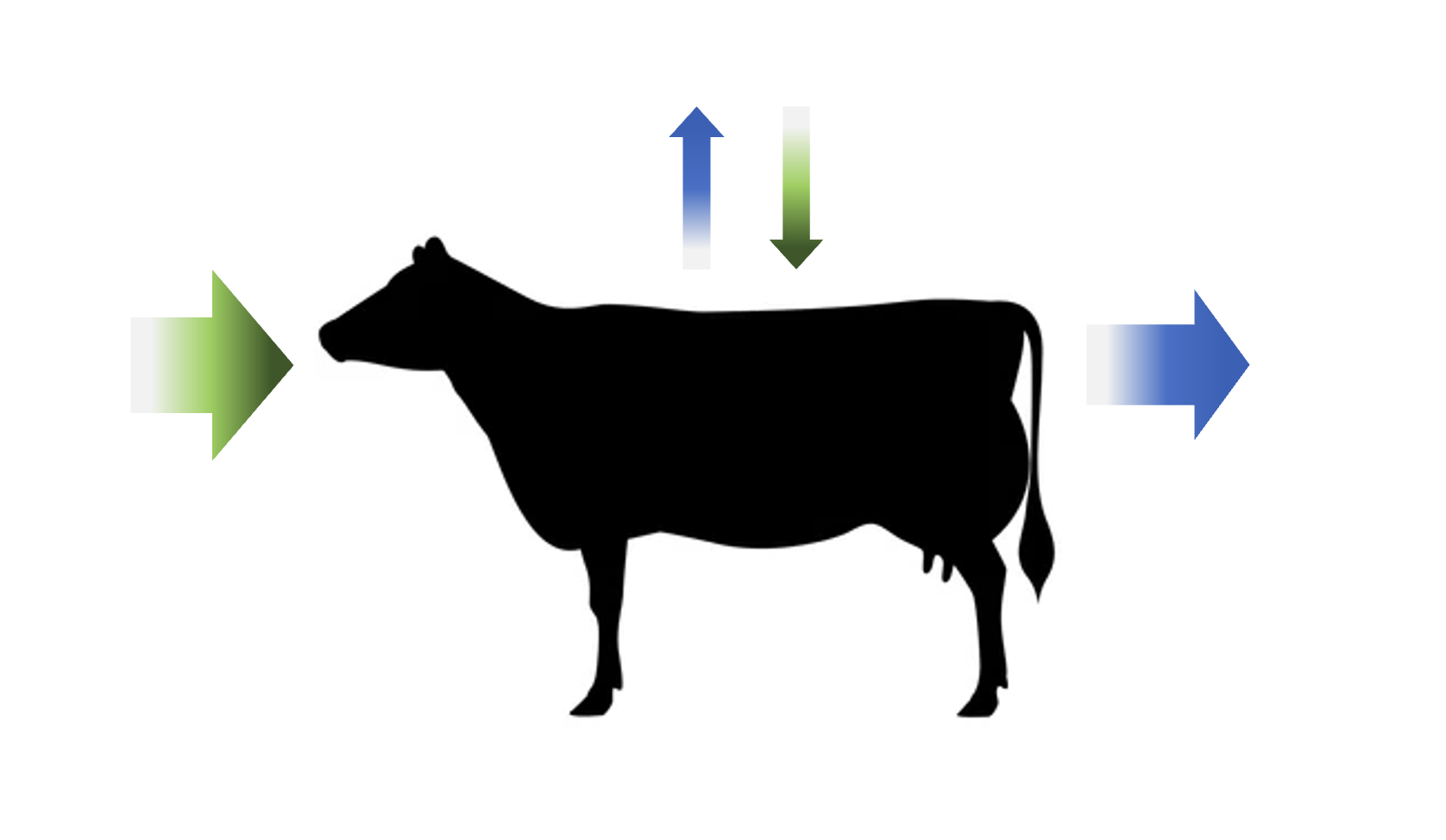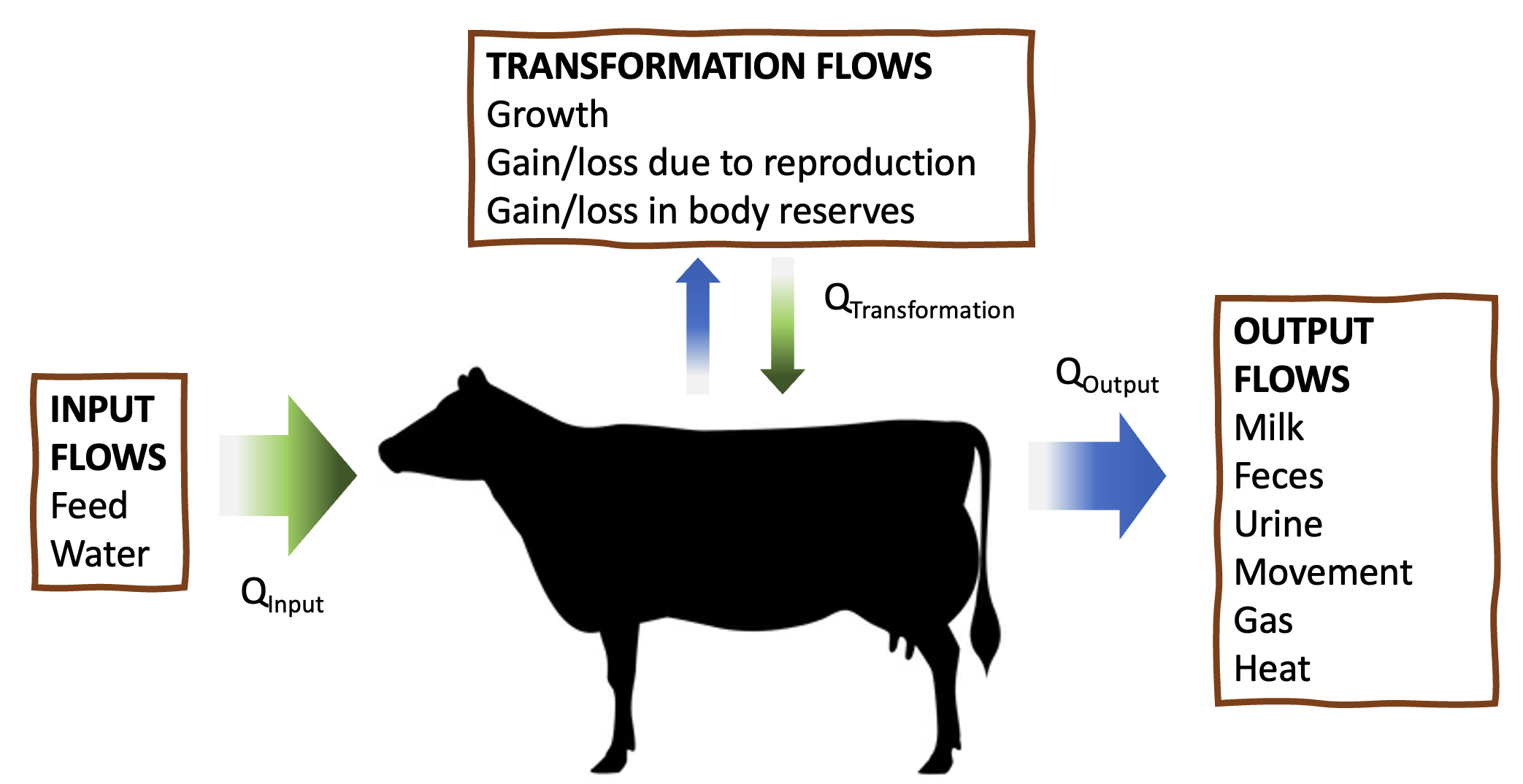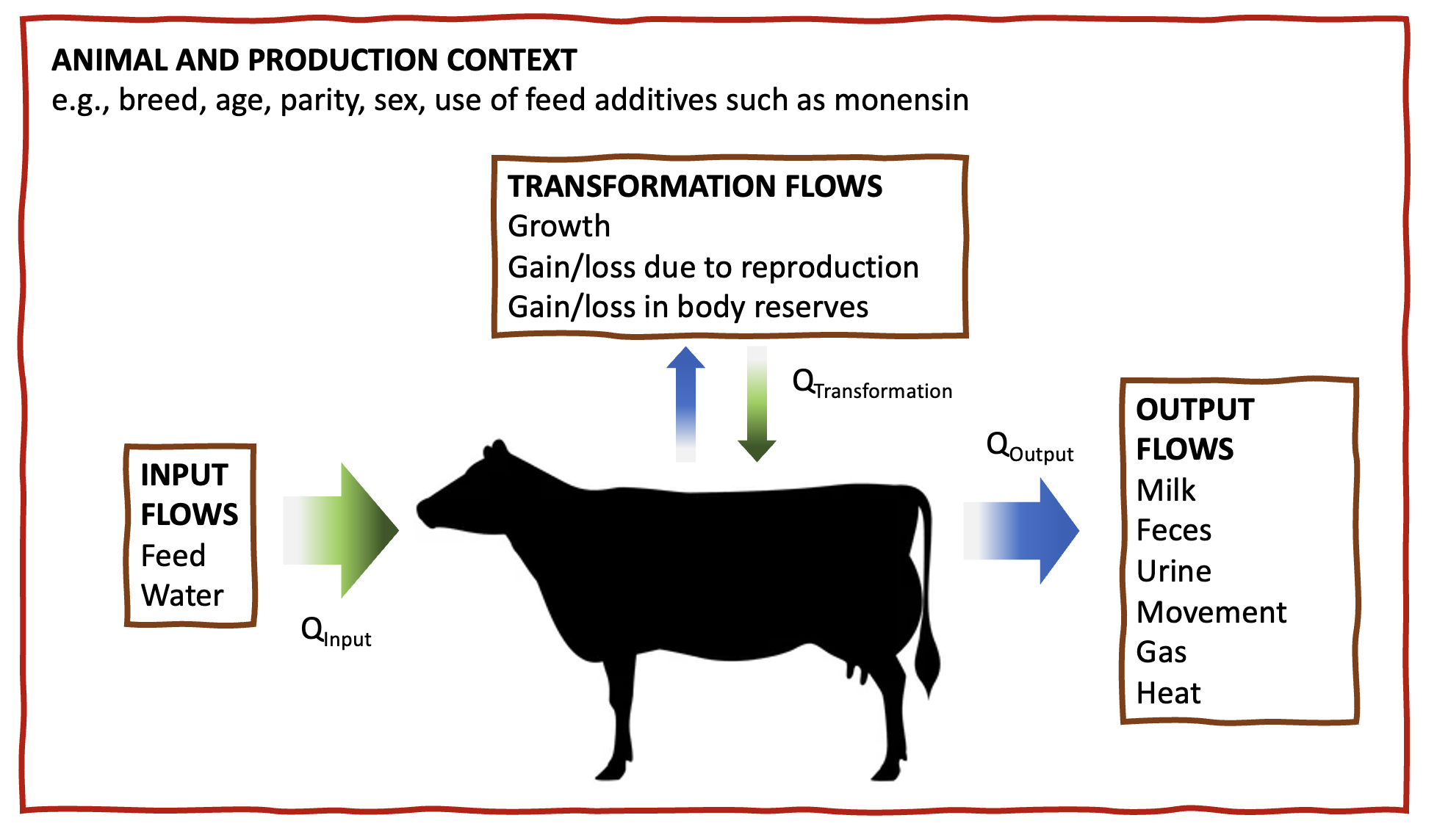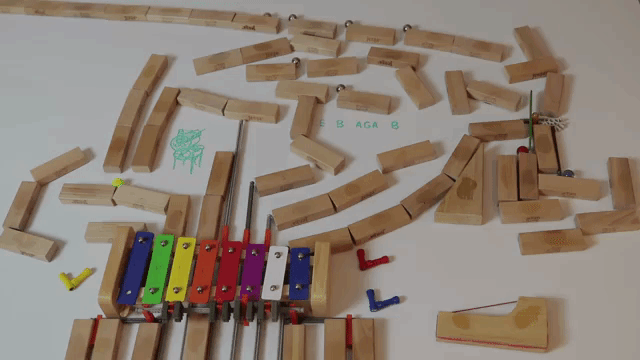Chapter 3 Systems concepts

Figure 3.1: Simplified representation of animal nutrition as a system
Learning Objectives
- Map out the basic structure and boundaries of a single-animal nutritional system, using systems thinking concepts.
- Explain physical/chemical and biological principles that apply across animal nutrition.
- Give specific examples of 1) inputs, 2) outputs, and 3) means by which the system is transformed for a dairy ruminant.
3.1 The animal nutritional system
In the last chapter, we created a simple nutritional model that represented three pieces of information: feed intake, body weight, and parity. Yet as animal scientists, we have access to much more information about feeds, animals, and outcomes than just these three variables. As we start to build more complex models that include more variables, we will quickly confront a problem...how can we organize the many different pieces of information we can collect about an animal's nutrition?
In this chapter, we will begin to think about the animal as a nutritional system. Specifically, we will consider the boundaries of nutritional knowledge, discuss guiding principles, and sketch out the configuration of a single-animal nutritional system, using dairy cattle examples.
3.2 Ways of understanding nutritional systems
Disciplines such as physics, economics, and animal nutrition each have their own ways of seeing the world. Animal nutrition is an applied discipline, so nutritionists make use of tools from various other disciplines to achieve practical goals. For a nutritionist, the most interesting aspects of an animal are the physical, chemical, and biological processes through which the organism intakes nutrients uses them to support its life.
Physical properties can be observed or measured without changing the composition of the substance. For example, freezing water changes its physical properties, but not its chemical composition. In contrast, chemical changes involve the substance reacting with other substances to change chemical composition. Finally, biological processes involve both physics and chemistry, and they are enacted in a living organism.
In practice, animal nutritionists manage many different aspects of animal systems, including social and economic components. For example, a dairy nutritionist in California might formulate rations that include lots of almond hulls, because this is a cheap feed source (economic) that is a byproduct of a process that humans value (social). A nutritionist might change the ingredient composition of diets based on the desire of some people for grass-fed milk (social).
A nutritional model such as NASEM (2021) does not take into account economic or social factors. It is based solely on physical, chemical, and biological properties of the animal system.
| Discipline | Nutrition in Practice | Nutritional Model |
|---|---|---|
| Physical | X | X |
| Chemical | X | X |
| Biological | X | X |
| Social | X | |
| Economic | X |
Nutrition is life itself!
If you've ever known an animal you truly loved, you might be thinking - an animal is more than just a nutritional system! This is true. Yet from the nutritionist's perspective, the biochemical processes of digestion and metabolism form the core of life itself. The animal's abilities to keep living, to grow, to move, to change, to reproduce, and to make milk are all outcomes of nutritional processes.
3.3 Systems concepts
Let's start building our understanding of a single-animal nutritional system. A single animal nutritional system is centered on the body of one animal. However, the boundaries of the system are not the body of the animal per se, because our nutritional system includes both the animal's body and the digesta in the gastrointestinal tract. Collectively, we will call the body and digesta the animal.
The animal is an open system--it interacts with its environment through inputs and outputs rather than being closed off to external forces. In our single animal nutritional system, the major inputs are the energy and nutrients in feed. Through the processes of digestion and metabolism, the inputs are transformed into various intermediates. Finally, the nutritional system has outputs such as milk, feces, urine, heat, and activity.
Of course, the lives of animals unfold over time. Consequently, nutritional systems occur over time. This temporal aspect adds some complications for developing nutritional models. To simplify, we often assume that a nutritional system is in a steady state condition, or in other words, in dynamic equilibrium. A system in steady state has inputs flowing in, and outputs flowing out, without the state of the system itself changing. For example, a mature animal that is not lactating or growing may have relatively stable nutritional system. In contrast, systems can move through transient states where the system itself is undergoing changes. For example, as a young animal grows, their nutritional system is constantly transforming. Still, sometimes these transformations are small enough to ignore over a short period of time (e.g., the growth of a calf over 4 days).
Because nutritional systems are dynamic, we almost always discuss their inputs, processes, and outputs in terms of rates (amounts per period of time) rather than amounts. However, as an additional simplification, we typically assume the denominator of the rate is one day in models such as NASEM. For example, we record the rate of dry matter intake (DMI, kg/d) and the rate of milk output (kg/d) in dairy nutritional trials. We can even model changes to the system itself one day at a time. For example, we can predict the nutrients required (amount per one day) for a calf to grow in body size (amount per one day).
3.4 Single-animal nutritional system
A few guiding principles are true across nearly all animal nutritional models. These principles inform the basic structure of the nutritional model and are considered by researchers throughout the processes of model development. These rules are core assumptions in animal nutrition that we will see repeated throughout the NASEM model.
3.5 Physical/chemical principles: Mass & energy balance
Based on the laws of thermodynamics, we know that matter and energy are neither created nor destroyed. Because we know mass and energy will be conserved, we can start to develop rules about our single animal nutritional system. These very simple rules will help us represent the nutritional system in mathematical terms.
At steady state, the flow (Q) of energy or mass into the system equals the flow out of the system:
\[
Q_{Input} = Q_{Output}
\]
At a transient state, the flow of energy or mass into the system equals the flow out, plus the flow into transforming the system itself at a given point in time. Transformations can involve accumulation (positive) or decumulation (negative) of energy and matter into the system.
\[ Q_{Input} = Q_{Output} + Q_{Transformation} \]
The laws of thermodynamics are universal, so we can apply these rules to the flow of energy, or to the flow of any element (carbon, nitrogen, phosphorus) across the system.
When applied to dairy cattle nutrition, input flows relate primarily to feed consumption. Elements and energy flow out of the animal in milk, feces, urine, and gas. Energy is transferred during movement and heat loss. Transformation flows occur when the animal's body grows, gains or loses tissues associated with reproduction, or gains or loses body reserves.

Figure 3.2: Representation of animal nutrition as a system, showing examples for each category of flows
Test yourself
An animal was fed some feed containing 400 g/d of phosphorus (P). Later, the researcher analyzed the outputs (feces and urine) from the animal and recovered 350 g/d of P. Was this animal apparently at a steady state, or a transient state? How do you know?
For math appreciators
If you are a math appreciator, you may notice some opportunities to use systems of differential equations to answer nutritional questions.
3.6 Biological principles: ordered processes
Nutritional systems involve many different processes from macroscopic to microscopic scales. For any nutrient and for energy, nutritional models typically describe a core sequence of nutritional processes:
- Ingestion - the input of nutrients, energy, and water to the gastrointestinal tract (GIT).
- Digestion - the mechanical and chemical breakdown of larger molecules into smaller substances that can be absorbed (e.g., fatty acids, amino acids, glucose, ammonia).
- Absorption - the passage of molecules into the body itself (into circulation) rather than remaining in the gastrointestinal tract.
- Assimilation and Use - at the cellular level, the use of nutrients and energy in chemical reactions that sustain life and body functions. Associated with output and transformation processes.
These nutritional processes can also be thought of as a set of rules. For example, a nutrient or energy must be ingested before it can be digested, absorbed, assimilated, or used. Therefore, we know that the gross amount ingested is always greater than the amount digested. The amount digested is greater than the amount available for metabolism. Finally, the amount available for metabolism is greater than the net amount used in output and transformation processes.
When energy and nutrients are mobilized from body reserves, they have already passed through the processes of ingestion, digestion, and absorption. Similarly, in nutrition trials where small-molecules are infused into the bloodstream or distal gastrointestinal tract, these nutrients "skip ahead" of ingestion and digestion.
3.7 Biological principles: context-dependence
The laws of thermodynamics and other physical/chemical rules are fairly universal--they hold true across many contexts. The same core processes of nutrition can be found across the Animalia kingdom. This gives us the basic configuration of a nutritional system that will be true across different types of animals. But beyond this, the structure and behavior of nutritional systems is dependent on the context.
For example, imagine the nutritional system of a lactating, high-producing Holstein fed a high-quality ration, versus that of a dry heifer fed a diet based on poor-quality forage. The principles of mass balance and the order of nutritional processes apply to both. Yet, we expect the specific behavior of the nutritional system will be vary between these two contexts.
Therefore, our final guiding principle states that the structure and behavior of nutritional systems is context-dependent. Elements of the context such as breed, genetics, production system, geographic region, etc., determine how the system functions. Sometimes, aspects of the context can be represented in nutritional models, as we will see in the NASEM model.
3.8 Conclusions
With these guiding principles, we can sketch out a rough outline of the configuration of a single-animal nutritional system for any nutrient or for energy. We know that our system will have inputs, outputs, and the potential to transform itself. We know that the system functions through core nutritional processes from ingestion to assimilation and use. We know that the specifics of the system behavior depend on contextual factors.

Figure 3.3: Representation of animal nutrition as a system, showing the overarching effects of contextual factors
Although we have made progress in establishing the basic configuration of a nutritional system, we want to be able to answer practical questions! For example:
- Does this diet supply enough minerals to support the growth and development of a 3-month old calf?
- How much dietary protein will it take to support the process of uterine involution in a postpartum cow?
- For an animal walking 1000 meters to the parlor each day, how much extra energy is required?
These questions require us to characterize the system in greater detail. In the subsequent chapters, we will discuss nutritional inputs, processes, and outputs in much greater detail. We will delineate which contextual factors have the greatest impact on nutritional system behavior. By the end, you will be able to use a nutritional model (NASEM) to predict how inputs will be split up into specific outputs (e.g., what amount of nutrient X will appear in milk, urine, feces) or used in system transformation.
Test yourself
Think about the illustration below showing how marbles flow through a series of blocks.
- Can you draw an analogy to mass balance? A) Discuss input, output, and transformation (accumulation) in terms of marbles flowing in and out of this system. B) In this system, what happens during steady state, and transient state conditions?
- In this system, all the marbles enter the same way. What determines where the marbles leave the system (which color tunnel) or where they get stuck in the system?
If you're losing your marbles, you can click below to see one interpretation of this marble sorter as a system.
Marbles are input at the top of the system and output at the bottom when they leave the blocks. A system transformation occurs when a marble gets stuck somewhere in the system, because it changes the form of the system and its reaction to new inputs. Steady state conditions would involve inputs equalling the outputs. In other words, the number of marbles in would equal the number of marbles out for a given period of time. Transient state conditions would involve the accumulation or decumulation of marbles, where the flow of inputs would not equal the flow of outputs.
In this system, the fates of marbles are determined by what blocks they run into, and possibly other factors such as the weight and size of the marble.

3.9 Questions
- Describe the core physical/chemical principles underlying nutritional models.
- List and describe the core sequence of ordered processes in nutrition.
- What is an open system, and how does it apply to animal nutrition?
- What is a steady state condition, and how does it apply to animal nutrition?
- Give examples of inputs, processes, and outputs in the nutritional system of a non-lactating animal.